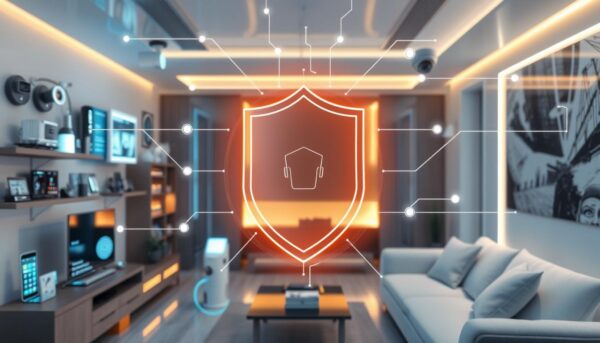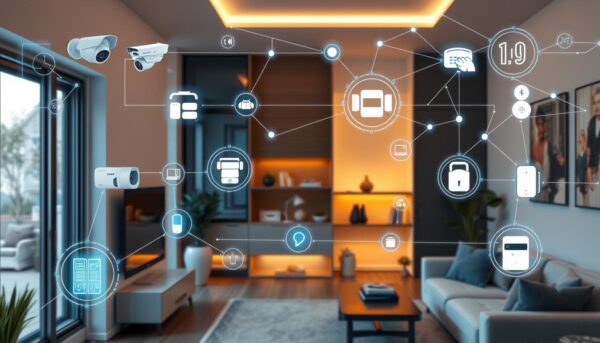✅ Last checked on
Have you thought about the security of your smart home devices? With smart home tech on the rise, keeping your devices safe is key. A 2019 FBI warning showed that even simple items like fridges and laptops should not share networks. This highlights the need to protect our homes from network threats.
By 2025, homes might have over 15 smart devices. This means more chances for hacking and cyber attacks. About 70% of ransomware attacks start with IoT devices that aren’t secure. This shows how important it is to stay alert about smart home security.
Key Takeaways
- Securing your Wi-Fi network is essential to prevent hacking and unauthorized access.
- Managing device passwords and enabling multi-factor authentication can add an extra layer of security.
- Regular updates and patch management are crucial for smart devices to prevent vulnerabilities.
- Using a guest network can isolate IoT devices from more sensitive devices, ensuring that compromised devices do not expose valuable information.
- Controlling personal information usage and understanding vendor data practices can enhance user privacy and security concerning smart devices.
- Implementing multi-factor authentication can significantly mitigate the risk of unauthorized access, particular against credential-stuffing attacks.
The Growing Importance of Smart Home Security
Securing your smart home devices is crucial. The global smart home security market is expected to grow from $14.68 billion in 2022 to $46.76 billion by 2028. This is a 20.93% annual growth rate. The rise in connected devices at home increases hacking and cyber attack risks.
Smart home security systems, like smart locks and surveillance cameras, add protection. About 30% of home break-ins happen through unlocked doors or windows. Smart systems alert you to these entry points. They also help save energy by 10-15% when integrated with home automation.
Understanding Modern Smart Home Vulnerabilities
Modern smart homes face risks like weak passwords and outdated software. Common threats include hacking, phishing, and ransomware attacks. Unsecured smart homes can lead to financial loss, identity theft, and data breaches.

Common Security Threats to Connected Devices
To keep your home safe, know the common threats to connected devices. These threats include:
- Hacking: unauthorized access to your devices
- Phishing: trying to steal your personal data
- Ransomware attacks: demanding payment to restore access
The Real Cost of Unsecured Smart Homes
Unsecured smart homes face big risks. Homes without security systems are three times more likely to be burglarized. Smart home security systems, including IoT and connected home security, offer extra protection. They help reduce the risk of security breaches.
Essential Steps for Securing Smart Home Networks
To keep your smart home devices and personal data safe, securing your network is key. With more smart homes in the U.S. expected to grow, network security is more important than ever. Start by changing your router’s default password and name. Also, enable WPA2 encryption to make your Wi-Fi network secure.
It’s important to make sure all devices on your network are safe. This includes smart locks, cameras, and other IoT devices. Use a router with built-in security features like a firewall and intrusion detection to protect against hacking. Also, keep your devices updated to fix security issues.

- Using strong passwords that are at least 12 characters long, combining uppercase letters, lowercase letters, symbols, and numbers
- Enabling multi-factor authentication to enhance account security
- Regularly updating devices and checking for the latest security patches
- Disabling tracking features on smart devices to protect your privacy
By taking these steps, you can greatly improve your smart home network’s security. This will help protect your devices and personal data from cyber threats. Remember, using strong passwords and enabling WPA2 or WPA3 encryption are crucial. They help prevent unauthorized access to your network and devices.
| Security Measure | Effectiveness |
|---|---|
| Changing default router password | Reduces risk of unauthorized access by up to 80% |
| Enabling WPA2 encryption | Secures Wi-Fi network and protects data |
| Regular software updates | Patches up to 90% of known security vulnerabilities |
Smart Device Password Management and Authentication
To keep your smart home devices safe, managing passwords and using multi-factor authentication is key. This step is vital for your connected home’s security and to stop unauthorized access. Many cyberattacks target small businesses and individuals, not big companies, making smart home security very important.
Using a password manager can help you create and keep unique, complex passwords for each device. This can cut down password retrieval times by 75% and prevent forgotten passwords. Also, two-factor authentication can block up to 99.9% of automated attacks on accounts, greatly improving your IoT security.
Some good practices for managing device passwords include making strong, unique passwords for each device and changing them often. It’s also wise to use a password manager to generate and store complex passwords. By following these tips, you can boost your smart home security and keep your devices safe from cyber threats.
By focusing on smart device password management and authentication, you can greatly lower the risk of unauthorized access to your connected home security devices. This is crucial, as about 81% of data breaches are due to weak or stolen passwords. By securing your devices, you can protect your smart home and enjoy IoT technology safely.
Advanced Features for Securing Smart Home Systems
To boost your smart home security, think about adding features like firmware updates and network segmentation. These can protect your smart locks and cameras. For example, Firewalla can watch your network for threats, keeping your devices safe.
Keeping your devices updated is key. Network segmentation splits your network into parts, each with its own security. This makes it harder for hackers to get around. It keeps your smart home safe, including your cameras and locks.
For more on securing your smart home, check out home network monitoring tools. Look for features like 24/7 monitoring and mobile access. A good smart home security system gives you peace of mind, knowing your home is safe.
Advanced smart home security offers many benefits. Here are a few:
- Improved network security
- Enhanced protection for smart locks and surveillance cameras
- Increased peace of mind
- Customizable alert settings
- Integration with emergency services
Conclusion: Maintaining Long-Term Smart Home Security
Keeping your smart home devices safe is a continuous effort. You need to stay alert and keep your devices and software up to date. This ensures you have the latest security updates and features.
It’s also important to know about the latest IoT security threats. This way, you can protect your smart home from potential dangers. Use tools that help monitor your devices for any vulnerabilities.
Setting up automatic software updates is a good idea. This way, your devices will always have the latest security patches. Using a security monitoring tool can also alert you to any suspicious activity.
Smart home security is not a one-time job. It’s an ongoing process that requires your attention and knowledge. By following the best practices mentioned here, you can enjoy a smart home while keeping it secure and private.